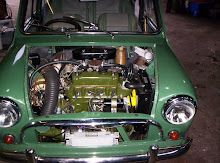The S.U. carburettor (type HS2 or HS4) fitted to the Minis has a much simpler jet assembly than other S.U. designs with which some readers may be familiar. The jet, a metal tube sliding in a single bearing bush, is fed with fuel through a small-diameter nylon tube. Thus the cork glands and sealing washers which were apt to be sources of petrol leakage on most earlier types of S.U. carburettors are no longer necessary. Apart from this, and changes in the design of the float chamber and float, the general construction of the carburettor is similar to other S.U. designs, and servicing and adjustment are carried out in the usual manner, as described later.
The carburettor does not contain a number of tiny jets and passages which can easily become clogged. Instead, a single large-diameter jet is used, the effective opening of which is varied by a tapered needle that is raised or lowered by a piston which rises and falls in response to changes in engine speed and throttle opening. The correct mixture strength is thus maintained under all conditions: moreover, the mixture strength at any point can be altered, if necessary, simply by substituting a needle that has a different taper.
Normally, the needle that is fitted as standard, as the result of extensive tests, will give the most satisfactory results. If fuel economy must take precedence over performance, however, or if the car is normally operated at a high altitude, a needle that gives a weaker mixture may be justified. Conversely, when the engine is tuned for increased performance a slightly richer needle may be needed. In such cases the local S.U. carburettor agent should be consulted or the advice of the S.U. Carburettor Co. Ltd., at Wood Lane, Erdington, Birmingham, 24, should be sought. The method of examining or changing the needle is described on page .
The only routine attentions required are occasional topping-up of the small oil chamber in the upper part of the suction chamber, as described in Chapter 3, and an occasional check on the adjustment of. the slow-running mixture strength and speed. At comparatively long intervals— say, once every 12,000 miles or yearly—the suction chamber and the piston should be cleaned.
On earlier cars the mixture control knob is marked "Choke" or "C," while on later models a symbol representing a primitive form of choke is used. The term "choke" when applied to the control which provides a rich starting mixture is, of course, incorrect when considering an S.U. car¬burettor, since the rich mixture is not provided by choking or throttling the air inlet to the carburettor, but by lowering the jet away from the jet needle, as just described.
Thursday, 15 October 2009
The Carburettor
Posted by Info Mini Cars at 04:09
Subscribe to:
Post Comments (Atom)


0 comments:
Post a Comment